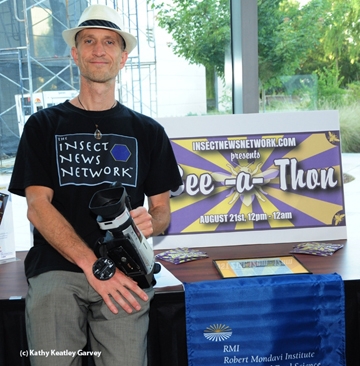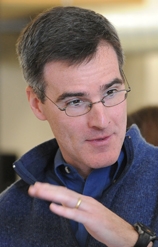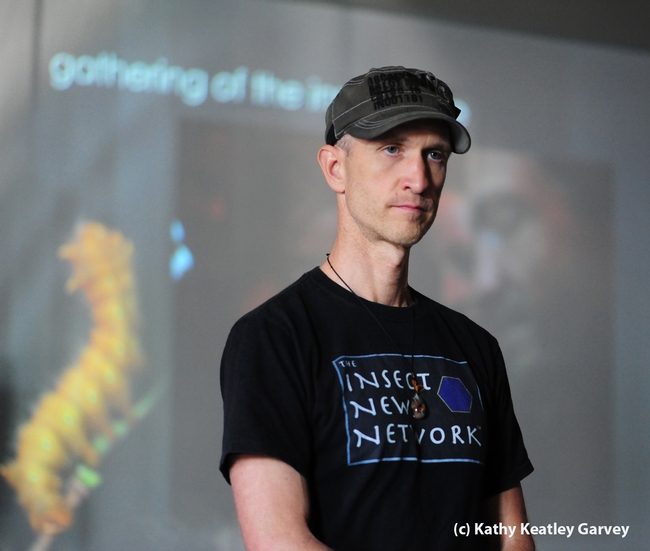- Author: Kathy Keatley Garvey
If you're wondering which bug won "Bug of the Year" in Emmet Brady's Insect News Network (INN) radio poll, it's not the honey bee.
But there is a "bee" in its name. It's the "long-nosed bee fly."
I once captured an image of that curious critter in the Storer Garden, UC Davis Arboretum (see below)
"This nominee is a personal favorite of the team @ The INN for it is bodacious!," Brady wrote on the INN website. He broadcasts INN on Wednesdays from 4 to 5 p.m. and Fridays from noon to 1 on KDRT 95.7 FM, Davis. You can also listen online.
"Long-nosed bee flies (Bombylius major) stay low to the ground are highly territorial and are easy to track," Brady wrote. "Unlike the majority of glyciphagous dipterans, the bee flies feed on pollen (from which they meet their protein requirements). A similar trophic behavior occurs among the hover flies, another important family of Diptera pollinators.
"Watching these flies argue over a flower or a patch of plants is pure enjoyment for the whole family. While the Bombyliidae include a large number of species in great variety, most species do not often appear in abundance, and for its size this is one of the most poorly known families of insects. There are at least 4,500 described species, and certainly thousands yet to be described. So if you pay attention and plant the right flowers, you may be able to create a Citizen Science project that is a little Hollywood and a little Natural History Museum. You might even discover a new species, and then you can name it whatever you want!"
The first runner-up? The honey bee. Interesting that the long-nosed bee fly and the honey bee were "neck and neck" for awhile.
Brady is delighted that the bee fly won because it's a fairly unknown and unusual bug--a bugs that doesn't get much attention.
As for the honey bee, it's "the perennial candidate for the Bug of the Year (BOTY)," Brady says, acknowledging that the honey bee "perhaps the most important insect to human civilization."
So, bee fly, first. Honey bee, second.
Here's the top 10:
1. Long-Nosed Bee Fly
2. Honey bee
3. Kirk Jellum’s Praying Mantis Sculpture from Burning Man
4. The Monarch Butterfly
5. Madagascar Sunset Moth
6. Ogre-Faced Spider
7. Elephant Hawk-Moth Caterpillar
8. Mirror Spider
9. Salt Marsh Tiger Beetles
10. Orchid Bee
You know which of the 25 nominees for Bug of the Year came in dead last?
The mosquito! It's "not last but not least..." It's "last and definitely least."
Nobody likes the mosquito.

- Author: Kathy Keatley Garvey

Inquiring minds want to know.
At least one inquiring mind wants to know.
Journalist/cultural entomologist Emmet Brady of Davis, who reaches out to bug and non-bug people alike on his Davis-based radio show, "Insect News Network," is hosting his annual Bug-of-the-Year contest through Jan. 14. You can hear his show Wednesdays from 4-5 p.m. and Fridays from 12 p.m. to 1 p.m. on KDRT 95.7 FM, Davis.
Last year the Australian Peacock Spider won Brady's contest. A spider? That's perfectly fine. Spiders are not insects but they fit quit well into the "Bug of the Year" candidates. And, they have excellent credentials.
And speaking of peacock spiders, you should check out Gwen Pearson's blog on Charismatic Minifauna: New Species of Peacock Spider Dances for You--and Sex and watch the video of this fascinating spider. Pearson, who holds a doctorate in entomology, initially began blogging as "The Bug Girl."
Emmet Brady urges everyone to vote, and vote often. Access the vote page here. "You can vote as many times as you like, for as many bugs as you like," Brady says, "but only one per visit, however."
And the 25 contenders? Drum roll, please:
- Yellow-Headed Soldier Fly
- Green Lynx Spider
- Monarch Butterfly
- Oregon Yellow-Faced Bumble Bee
- Madagascar Sunset Moth
- Salt Marsh Tiger Beetles in Love
- Variegated Meadowhawk Dragonfly
- Orchid Bee
- Tizsa Flower Mayflies
- Golden Spotted Oak Borer
- Long-nosed Fly
- Robobees
- Praying Mantis Sculpture
- Ogre-Faced Spider
- Honey Bee
- Magicicada
- GM Mosquito
- Asian Citrus Psyllid
- T Mirror Spider
- Himalayan Spider
- Brown Marmorated Stink Bug
- The Map Butterfly
- Ant-Mimick Tree Hopper
- Bird-Dropping Spider
- Elephant Hawk-Moth Caterpillar
Brady kindly lists their qualifications. For example, he writes about the honey bee:
"The perennial candidate for the BOTY, the honey bee is perhaps the most important insect to human civilization. They represent in many ways a pinnacle of invertebrate evolution, as well as a complex and mystical interdependence with humans. The bee has significance in almost every facet of our existence: ecological, economic, spiritual, historical, psychological, artistic, biomimetic and sociological. Honey bees belong to the genus Apis, with 7 species worldwide. There were no 'true' honey bees in the Western Hemisphere until the 17th century. They embody a omnipresent contradiction in modern ecology: today, there are more honey bees on the planet than at any time in history. However, the use of bees as agricultural tools has led to mismanagement and disrespect, as their commercial numbers have plummeted as much as 60 percent in the past 20 years."
If none of these bugs is for you, wait--there's another one. It's called "other."
Just type in your favorite. Either way, this bug's for you.

- Author: Kathy Keatley Garvey

Brady, a cultural entomologist, hosts the Insect News Network on KDRT 97.4 FM Radio, Davis, and every year he hosts a "Bee-a-Thon" to spotlight honey bees.
So, get ready for Bee-a-Thon 3!
The free multimedia event will begin online with a series of videos about honey bees and other members of the Microcosm, including videos created by Brady and clips from previous Bee-a-Thons.
UC Davis will be represented by Eric Mussen, Extension apiculturist with the UC Davis Department of Entomology and Nematology; and entomologist/artist Diane Ullman and artist Donna Billick, co-founders and co-directors of the UC Davis Art/Science Fusion Program. Mussen, a member of the department since 1976, is world-renowned for his honey bee expertise. Ullman is the associate dean of undergraduate academic programs in the UC Davis College of Agricultural and Environmental Sciences and a professor of entomology.

Among the others to be interviewed will be Kim Flottum, longtime editor of Bee Culture magazine; Ria de Grassi, director of federal policy, California Farm Bureau; Eddie Dunbar, founder of the Insect Sciences Museum of California; Celeste Ets-Hokin, creator of the Pollinator Gardens at Lake Merritt, Oakland; and Mike Somers, state director of Pesticide Watch and the Pesticide Watch Education Fund.
The schedule includes:
- a pollination fundraising luncheon, with a honey-inspired menu, from noon to 1 p.m. at Monticello Seasonal Cuisine, 630 G St. (not broadcast).
- fruit presentations from 1 to 1:30 p.m. at the Davis Food Co-Op, 620 G St.; (not broadcast)
- a live broadcast from 2 to 4 p.m. on Davis Community Television public access Channel 15
- a radio/video feed from KDRT, 95.7 FM, from 4 to 6 p.m.
- BATMAP (Bee-a-Thon Monster After Party) billed as the world’s first Pollinator Party from 7 to 10 p.m. at the Davis Media Access, 1623 Fifth St., and featuring music by Eminent Bee. Admission is free, but guests must come adorned as an insect, spider or flower.
- a lounge chat from 10 p.m. to midnight at deVere’s Irish Pub, 217 E St.
We've posted several photos and the schedule on the UC Davis Department of Entomology and Nematology website. Be sure to check out the Insect News Network website for more information.
Brady says the art-science event is designed to ignite a community about the full story about honey bees and other pollinators — "not just the science, but the art, the anthropology, the technology and design, the pop culture."
“The interdependence we have with insects — especially bees — is profound and complex and most people are only discussing half the story," said Brady, who holds a bachelor’s degree in biology from Hiram (Ohio) College. "The key word is biocomplexity — how human behavior fits into the global ecology. It’s also about how insects inspire and amaze our society. That will all be covered on the show.”
Brady described the Bee-a-Thon as timely; Time magazine just published a cover story on “beepocalpyse.”
We know Emmet Brady to be passionate about honey bees. And we know that the Bee-a-Thon will be educational, informative and entertaining.
When Brady talks about the "wonderful world of pollinators," he's thinking of the simple things we take for granted, the ABCs, if you will.
A honey bee on an Apple.
A honey bee on a Begonia.
A honey bee on a Cucumber.



- Author: Kathy Keatley Garvey
That should be easy to do. There's so much to say.
One hour.
Entomologist/artist Diane Ullman, associate dean for undergraduate academic programs in the UC Davis College of Agricultural and Environmental Sciences and professor of entomology, will be interviewed for an hour-long program on the Insect News Network, a Davis-based radio station, on Wednesday, March 20.
Emmett Brady, founder of the Insect News Network, KDRT 95.7 FM, and host of the “Wednesday Science Doubleplay,” said he will dedicate the entire hour from 5 to 6 p.m. to discussing Ullman’s unique and inspiring career.
"We will explore Ullman’s innovation in academics and education: from her pioneering efforts in the UC Davis Art/Science Fusion Program to her specialty: thrips."
The Art/Science Fusion Program, founded and directed by Ullman and her colleague, self-described "rock artist" Donna Billick, connects art to science, and science to art.
Brady also will examine the emergence of cultural entomology as a key discipline of the 21st Century and “how careers in science are being re-defined as scientific technology continues to res-shape the modern world.”
For the first hour (4 to 5 p.m.) of the “Wednesday Science Doubleplay” show, Brady will explore “the world of insects, beyond the creepy and the crawly to the fun, the fascinating, the profound and even the sublime.”
Just recently Ullman, along with a team of eight other investigators from six institutions, received a five-year, $3.75 million grant from the Agriculture and Food Research Initiative, United States Department of Agriculture's National Institute of Food and Agriculture, to develop and implement a national scientific and educational network to limit thrips-caused crop losses.
Meanwhile, listen to Diane Ullman's Tedx seminar. And then tune in to Insect News Network to hear an amazing entomologist, artist and administrator.

- Author: Kathy Keatley Garvey
Are you ready for the Great Bee Count?
It's happening Saturday, Aug. 11.
You're encouraged to be a "citizen scientist" and count the bees in your backyard or garden over a 15-minute period and to watch or listen to a national online video broadcast at http://www.yourgardenshow.com/bees between 8 and 10 a.m., Pacific Time. (Those are Pacific times; consult the website for the schedule in other time zones.)

Brady, a cultural entomologist and journalist from Davis, describes the event as a special “BEE” broadcast (Bee curious, Bee aware and Bee a good neighbor).
The Great Bee Count also will feature Brady’s footage of the UC Davis Department of Entomology's Häagen-Dazs Honey Bee Haven on Bee Biology Road.
The online video broadcast also will include a question-and-answer session moderated by Ian Cook.

What's it all about? The program is about creating a discussion and activity forum for new or experienced beekeepers, and “all of us who would like to learn more about bees and bee conservation, pollinators and backyard citizen science,” according to the YourGardenShow website.
The schedule (Pacific Time), subject to change:
8 a.m. – 8:30 a.m.
Emmet Brady, host, interview with Gretchen Le Buhn, San Francisco State University (from the first-ever Bee-a-Thon)
Eric Mussen, Extension apiculturist, UC Davis Department of Entomology
Robbin Thorp, native pollinator specialist and emeritus professor, UC Davis Department of Entomology
Neal Williams, pollinator ecologist and assistant professor of entomology, UC Davis Department of Entomology

Gretchen LeBuhn / Great Sunflower Project
Eric Mader – Xerces Society for Invertebrate Conservation
Kim Flottum – Editor of Bee Culture journal
Jennifer Berry - Apiculture specialist at the University of Georgia.
9 a.m. – 9:30 a.m.
Gretchen LeBuhn / Fred Bove Great Sunflower Project
Kim Flottum – Editor of Bee Culture journal
Jim Fisher – NYC BeeKeepers
Neal Williams, UC Davis Entomology
Robbin Thorp, UC Davis Entomology
Eric Mussen, Extension Apiculturist, UC Davis Department of Entomology
9:30 a.m. – 10 a.m.
Jennifer Berry - Apiculture Specialist at the University of Georgia
Arnold Van Vliet - Biologist at Wageningen University, Netherlands
Stephen Buchmann - North American Pollinator Protection Campaign
Gretchen Le Buhn, San Francisco State University (from the first-ever Bee-a-Thon)
You may remember Brady for several reasons.
(1) Last year he hosted the first-ever Bee-A-Thon, a global online marathon dedicated to raising awareness about honey bees and other pollinators.
(2) He's an innovator in the emerging field of cultural entomology
(3) He's the creator of the popular radio program, Insect News Network (.com), now based in Davis. It airs every Wednesday from 4 to 5 p.m on KDRT 95.7 FM.
A founding member of the Biomimicry Guild Speakers Bureau, Brady has lectured at seven universities across India. More locally, he co-founded the San Francisco Bay Area Green Tours. And now, he's authoring the Wikipedia entry for cultural entomology and a book entitled "Humvees and Honeybees: An Introduction to Cultural Entomology."
His passion for entomology extends to his given name, "Emmet."
It means “ant” in Gaelic.




